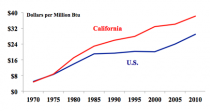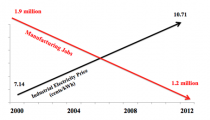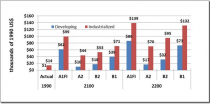The Supreme Court, in Mass v. EPA, stated that the EPA must treat CO2 and other Greenhouse Gases (GHGs), as “pollutants” and then carryout an analysis to determine whether the increasing concentrations in atmospheric CO2 may reasonably be anticipated to endanger human health and welfare. The Court did not mandate regulation; rather it mandated that EPA go through an Endangerment Finding process.
EPA did so and on December 15, 2009 issued its ruling that CO2 and other GHGs must be regulated. This EPA finding and associated rulings were immediately challenged in the DC Circuit Court. The DC Circuit ruled in favor of EPA, but given the two strong dissents from the December 20, 2012 decision denying rehearing en banc, the matter is likely going to the Supreme Court.
On Thursday, May 23, 2013, 11 scientists submitted an Amicus brief to the Supreme Court in support of the Southeastern Legal Foundation ( SLF) et al’s Petition for a writ of certiorari. (see PDF) )
SLF’s petition is the only petition to the Supreme Court that includes a purely science argument developed to show that EPA’s CO2 Endangerment Finding (EF) should be Vacated. Other Petitioners argue that such a decision is in order but make purely legal or process arguments.
Both the aforementioned Amicus brief and the SLF brief argue that each of the Three Lines of Evidence EPA uses to arrive at its 90-99 % certainty regarding its EF are very highly questionable. More specifically, the science portion of the Amicus Brief concludes with the following statement:
“Amici believe that no scientists have devised an empirically validated theory proving that higher atmospheric CO2 levels will lead to higher GAST. Moreover, if the causal link between higher atmospheric CO2 concentrations and higher GAST is broken by invalidating each of EPA’s three lines of evidence, then EPA’s assertions that higher CO2 concentrations also cause sea-level increases and more frequent and severe storms, floods, and droughts are also disproved. Such causality assertions require a validated theory that higher atmospheric CO2 concentrations cause increases in GAST. Lacking such a validated theory, EPA’s conclusions cannot stand. In science, credible empirical data always trumps proposed theories, even if those theories are claimed to (or actually do) represent the current consensus.”
It is absolutely critical that those parties interested in this matter focus on the validity of EPA’s Three Lines of Evidence (3LoE) and decide for themselves where they stand on this matter. The science argument contained in the Amicus has many advantages. It is easy to explain to laymen and it is the only purely science argument direct at EPA’s 3 LOE going to the Supreme Court in an effort to Vacate EPA’s EF.
Finally, you may also find quite interesting the concluding Amicus section that points out the numerous science -related legal errors the EPA committed which taken together all but guaranteed that its EF- related analytical process was grossly flawed. Moreover, at least two decisions by the D.C. Circuit made it significantly less likely that the court would decide EPA’s EF process was flawed. PDF
E. Calvin Beisner, Ph.D., Cornwall Alliance for the Stewardship of Creation
One doesn’t know whether to laugh or cry.
Democratic Rep. Barbara Lee of (wouldn’t you know it?) California, six other congresswomen (D-CA/CA/USVI/NY/MN/IL), and five congressmen (D-MN/GA/AZ/CA/NY) have introduced House Congressional Resolution 36, calling America to fight “climate change,” aka global warming (of which there’s been none for over 16 years now), to prevent women from becoming prostitutes.

No, your eyes didn’t fool you. The resolution claims that poor women are “vulnerable to situations such as sex work, transactional sex, and early marriage that put them at risk for HIV, STIs, unplanned pregnancy, and poor reproductive health.” “Sex work” and “transactional sex” are euphemisms for prostitution.
Ignore in passing that it’s not “sex work” and “transactional sex” per se but the associated risks they bring that bother the resolution’s sponsors. I guess the prostitution would be okay with them if it just weren’t for those nasty side effects.
The irony of the resolution comes from a fact hidden in plain sight: According to the “the world’s most authoritative scientific effort to understand and address changes in the Earth’s climate,” the UN Intergovernmental Panel on Climate Change (IPCC), poverty will shrink more with global warming than without it, not just for the wealthy West but also for the developing Rest.
Why? Because IPCC’s warming scenarios are based on its economic forecasts. More economic growth, according to its models, causes more warming; less growth, less warming.
And we’re not talking about tiny changes at the margin - lifting people from abject poverty to slightly more tolerable poverty. We’re talking about lifting people from grinding, life-shortening poverty into a standard of living that meets or surpasses that of today’s industrialized countries.
Surprised? Not if you’ve been following IPCC Working Group III, which studies warming’s impacts, or the Stern Report, a British government effort to forecast economic impact of warming through this century. (Neither IPCC nor Stern, by the way, is known for understating the risks from global warming.)
Let’s put some hard numbers to the discussion.
IPCC offers various scenarios for warming, each based on a scenario for economic development. Under its coolest - “B1,” according to which the world keeps global warming down to 3.8F by 2100 after subtracting losses caused by the warming, developing nations’ gross domestic product (GDP) per capita rises from $900 in 1990 to $39,400 in 2100. Under its warmest scenario, “A1F1,” with high economic growth depending on lots of fossil fuel use and consequently lots of carbon dioxide emissions, the world warms by 7.2F by 2100 and developing nations’ GDP per capita rises, after subtracting for losses from warming, to $61,500, which is about one-fourth higher than America’s today.
Economist Indur Goklany, who has been studying the economic effects of both global warming and climate policy for over two decades, lays out all the likely scenarios in “Is Climate Change the Number One Threat to Humanity?” in the peer-reviewed journal Wiley Interdisciplinary Reviews: Climate Change. One figure, reproduced here, sums up the story.
“Net GDP per capita, 1990-2200, after accounting for the upper bound estimates of losses due to global warming for four major IPCC emission and climate scenarios. For 2100 and 2200, the scenarios are arranged from the warmest (A1FI) on the left to the coolest (B1) on the right. The average global temperature increase from 1990 to 2085 for the scenarios are as follows: 4 C for AIFI, 3.3 C for A2, 2.4 C for B2, and 2.1 C for B1. For context, in 2006, GDP per capita for industrialized countries was $19,300; the United States, $30,100; and developing countries, $1,500.” Source: Goklany, “Is Climate Change the Number One Threat to Humanity?” pre-publication draft.
So, if poverty drives women into prostitution, and if Congresswoman Lee and her colleagues don’t want that result, they should submit an entirely different resolution: “Protect the Poor, Prevent Prostitution: Don’t Fight Global Warming!”
E. Calvin Beisner, Ph.D., is founder and national spokesman of The Cornwall Alliance for the Stewardship of Creation.
“Excessive energy costs have helped obliterate the state’s manufacturing base” Wall Street Journal, 03/ 29/ 2013
Coal based energy is a key factor in global socio-economic development, transforming agrarian societies to modern industrial ones. This societal transformation, driven by the accumulation of income and wealth, eliminates many contagious diseases, reduces child mortality, and lengthens adult life expectancy. Throughout the world, rapid emergence from poverty has proceeded as countries develop electricity networks based on coal. These systems are capable of achieving massive economies of scale that provide large amounts of power at low cost, stimulating technological change, spurring productivity growth and raising living standards. It is no coincidence that coal provides over 40% of the world’s electricity. Consumers prefer low-cost and reliable power. Proponents of so-called “carbon-free” energy (e.g. wind) argue that their low market shares are the result of market distortions, such as the absence of a market price for environmental externalities. The fundamental reason for these low market shares, however, is that such intermittent sources are considerably more expensive than coal. To promote inherently uncompetitive technologies, some governments have resorted to subsidies and production mandates. These policies not only increase government spending but also impose hidden efficiency costs on the economy that silently erode our standard of living. Consumers end up paying more for energy and getting less. Spending that once went for education and housing is diverted to energy expenditures. Manufacturers also pay more for energy and they pass these higher costs on to consumers who end up paying even more for goods and services. Consumers are then forced to cut back again. The result is a compounding of efficiency losses throughout the entire economy.
California is the poster child of how an extreme anti-coal agenda is adverse to human health and welfare. California has disdained the nation’s most affordable and reliable source of electric power in favor of unreliable and expensive non-dispatchable sources such as wind and solar. Not surprisingly, California’s baseload electricity supply is now at risk and costs are dramatically on the rise. The urban legend that California’s energy policies are somehow superior to those of other states is being unmasked as the social and economic predicament of the state’s families and businesses becomes ever more apparent.
The Rhetoric
The Reality of California
“Energy policies in the state of California are very advanced compared to the rest of the nation,” California Council on Science and Technology, 2012
THE FACTS
Electric rates 40% above the national average
12 million people eligible for LIHEAP
700,000 manufacturing jobs lost since 2000
Budget deficit of $25 billion in 2011
Negative net worth of $127 billion in 2013
More children in poverty than Nebraska has people

Electricity Prices: California vs. the U.S. (Enlarged)
“...(an) important factor that is pushing manufacturing jobs out of California is the rising cost of electricity, caused by the states ill-conceived energy policies… What is already unreasonable will only become more so with the new mandates” POWER Magazine

(Enlarged)
Based on a set of speculative computer models and despite rising electricity prices, one of the nation’s highest unemployment levels and severe questions about grid reliability, California has nevertheless has proceeded with AB 32, the so-called “Global Warming Solutions Act”. This cap and trade program seeks to reduce greenhouse gas emissions to 1990 levels by the end of this decade. that is in just seven years. While the impact of this excessive legislation has yet to be determined, the California Manufacturing and Technology Association has estimated that AB 32 will cost consumers $135 billion by 2020 almost two-and-a-half times the annual funds spent on K12 education. AB 32 will lower the states 2020 GSP by $153 billion a loss of 5.6%. California will have 262,000 fewer jobs in 2020 because of AB 32 and energy expenses for the average family will increase $2,500 per year. AB 32 will reduce state and local tax revenues by over $7.4 billion annually an amount exceeding 10 years of funding for the Children’s Medical Services Program. The energy facts of life are catching up to the “Golden State”.

California’s Electricity Rates in Perspective (Enlarged)
“CPUC has approved nearly every renewable contract filed by the utilities, even when they rate poorly on least-cost, best-fit criteria.” California Division of Ratepayer Advocates
“The “Rate Impact Bomb” is lingering on the horizon”
CPUC Commissioner Michel Florio

California’s Electricity Rates and Manufacturing Jobs (Enlarged)
“Manufacturing jobs provide benefits to workers with higher overall compensation than other sectors, and to the economy through innovation that boosts our nation’s standard of living,” U.S. Department of Commerce, 2012
In a departure from historical reality, California’s political agenda views energy as a social problem. Policymakers are implementing an energy plan that is adverse to human health and welfare. Reliance on untested, unverified and idealized computer models is steadily destroying the future of the state raising rates, driving industry away, increasing unemployment, putting more people into poverty and placing both energy security and reliability at risk. After the deregulation debacle in the mid-90s they should know better. That earlier academic exercise cost consumers hundreds of billions of dollars, destroyed jobs and ousted Gov. Gray Davis through voter recall. In a critique of the state’s latest experimental foray into energy, California’s Independent Oversight Agency the “Little Hoover Commission” concluded the state has not done a legitimate cost-benefit analysis and warned of a “rate impact bomb” by 2016. That’s when consumers will have to start fully paying for the massive array of costly renewable projects the CPUC so cavalierly approved the last few years. And this time, reifying the results of esoteric computerized scenarios is taking an even greater human toll. The impacts of the drastically escalating rates associated with these ill conceived anti-coal policies are real, not hypothetical abstractions. Over 1.7 million Californians are unemployed. And the problem is not going away California is regarded as the worst state in the Union for business a reputation that may haunt for decades:
Best and Worst States for Business 2012
“California’s climate change regulations will discourage energy intensive industries from locating in the state, and existing industry will have an incentive to relocate outside of the state” Boston Consulting Group, 6/21/2012
Californians will pay a heavy price for ignoring our most abundant and affordable energy resource. Clean coal technologies work and are continually evolving. In many other states, and in other parts of the world, emissions have steadily declined, while electricity from coal generation has significantly increased. Rhetoric and political posturing do not produce one kWh of electricity. Clean coal does and California should recognize this fact before it’s too late.
“...millions of Californians could soon experience power outages. As the state derives more of its electricity from renewables, it needs more “peak” gas-fired plants that can ramp up to meet demand when the sun isn’t shining and wind isn’t blowing”. The Wall Street Journal, 03/29/2013



